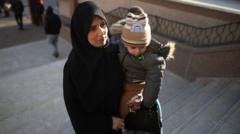Palestinians are making their way back to northern Gaza after months of military displacement, navigating the wreckage left by conflict. Despite the ongoing ceasefire, questions loom about the condition of their homes and the continued fragility of peace in the region.
Return to the Ruins: Displaced Gazans Head Back Home Amid Ceasefire

Return to the Ruins: Displaced Gazans Head Back Home Amid Ceasefire
Following months of displacement, tens of thousands of Gazans embark on a long-awaited journey back to their northern homes as the Israel-Hamas ceasefire holds.
Given the backdrop of conflict and uncertainty, here’s the latest update on the situation in Gaza:
As one of the largest waves of displaced Palestinians returns home, they face an arduous trek back to northern Gaza, nearly 16 months after being forced to flee due to Israel's military offensive. On Monday morning, a long line of people marched along Gaza’s coastal road carrying belongings on their backs and makeshift carts. This return comes as the fragile ceasefire between Israel and Hamas remains intact, despite a brief setback over the weekend.
The displaced individuals began arriving in Gaza City, where many were confronted with a landscape of devastation, as the Israeli military had reduced entire neighborhoods to rubble. After orders to evacuate northern Gaza in October 2023, around a million residents were forced to seek shelter elsewhere. The new returnees utilized various means—by foot, bicycles, and even handmade strollers to bring with them meager possessions of hope and survival.
Amid ongoing negotiations, tensions flared at the weekend when it appeared expectations regarding a hostage exchange were not met. However, a revised arrangement allowed for the return of displaced Palestinians starting at dawn on Monday. This tentative peace agreement also involved Hamas releasing a female Israeli civilian hostage, further complicating the delicate dynamics between the two sides.
In tandem with this, the health ministry in Gaza set up medical points along the paths, aimed at supporting those returning after over fifteen months of traumatic dislocation. An estimated 135,000 temporary shelters are urgently needed as many return to severely damaged infrastructures where 90 percent of buildings are reported destroyed.
The returnees, filled with mixed emotions of eagerness and fear, have expressed a sobering sense of loss over what awaits them upon their return. Still, hopeful to regain a semblance of normalcy, many are waiting for the right moment to reclaim their homes and rebuild their lives amidst chaos.
Analysts caution that while the ceasefire may hold for now, the fragile peace is contingent upon both parties' willingness to engage in meaningful negotiations, which remains unclear. Observers note that both Hamas and Israel desire to avoid further conflict, with no side wanting a full-scale war, especially as the tense situation continues to evolve with ongoing hostilities in the region.
The road ahead remains uncertain, but the resilience of those returning to their roots speaks volumes amid the backdrop of conflict and hope for a peaceful future.
As one of the largest waves of displaced Palestinians returns home, they face an arduous trek back to northern Gaza, nearly 16 months after being forced to flee due to Israel's military offensive. On Monday morning, a long line of people marched along Gaza’s coastal road carrying belongings on their backs and makeshift carts. This return comes as the fragile ceasefire between Israel and Hamas remains intact, despite a brief setback over the weekend.
The displaced individuals began arriving in Gaza City, where many were confronted with a landscape of devastation, as the Israeli military had reduced entire neighborhoods to rubble. After orders to evacuate northern Gaza in October 2023, around a million residents were forced to seek shelter elsewhere. The new returnees utilized various means—by foot, bicycles, and even handmade strollers to bring with them meager possessions of hope and survival.
Amid ongoing negotiations, tensions flared at the weekend when it appeared expectations regarding a hostage exchange were not met. However, a revised arrangement allowed for the return of displaced Palestinians starting at dawn on Monday. This tentative peace agreement also involved Hamas releasing a female Israeli civilian hostage, further complicating the delicate dynamics between the two sides.
In tandem with this, the health ministry in Gaza set up medical points along the paths, aimed at supporting those returning after over fifteen months of traumatic dislocation. An estimated 135,000 temporary shelters are urgently needed as many return to severely damaged infrastructures where 90 percent of buildings are reported destroyed.
The returnees, filled with mixed emotions of eagerness and fear, have expressed a sobering sense of loss over what awaits them upon their return. Still, hopeful to regain a semblance of normalcy, many are waiting for the right moment to reclaim their homes and rebuild their lives amidst chaos.
Analysts caution that while the ceasefire may hold for now, the fragile peace is contingent upon both parties' willingness to engage in meaningful negotiations, which remains unclear. Observers note that both Hamas and Israel desire to avoid further conflict, with no side wanting a full-scale war, especially as the tense situation continues to evolve with ongoing hostilities in the region.
The road ahead remains uncertain, but the resilience of those returning to their roots speaks volumes amid the backdrop of conflict and hope for a peaceful future.























